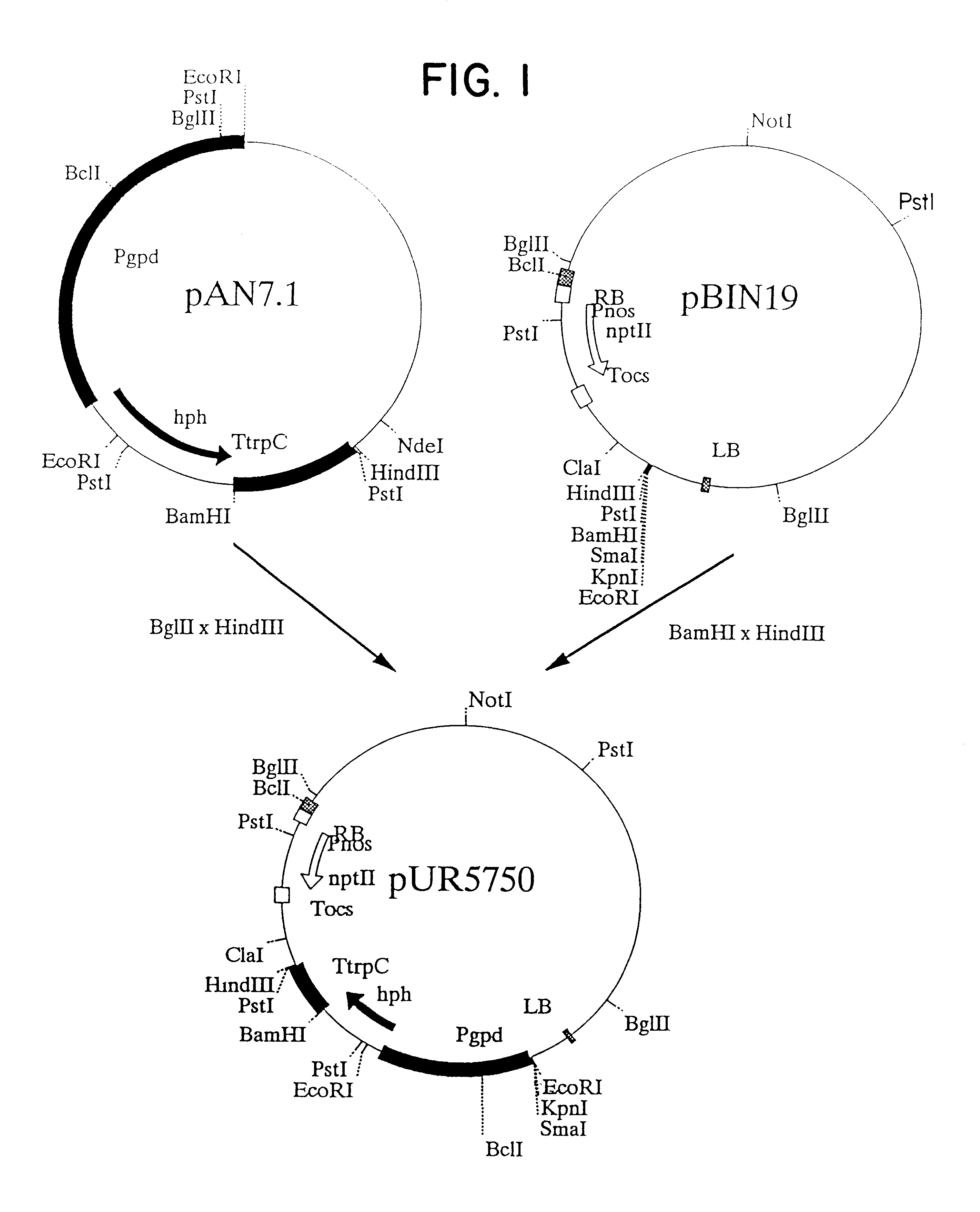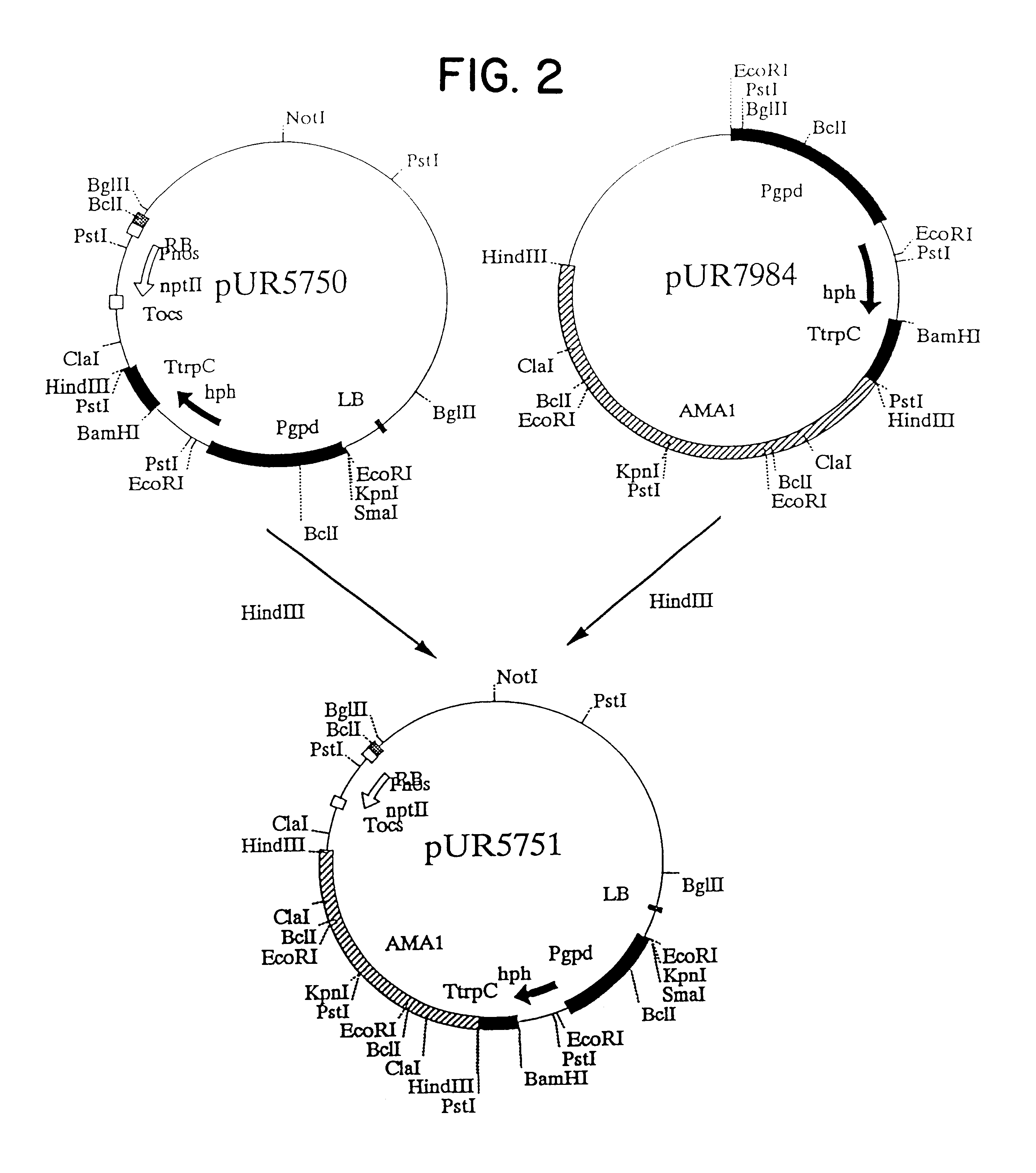Agrobacterium mediated transformation of moulds, in particular those belonging to the genus Aspergillus
a technology of agrobacterium and mould, applied in the field of agrobacterium mediated transformation of mould, can solve the problems of less effective transformation of microorganisms by agrobacterium tumefaciens than that of plants, a. tumefaciens transformation of microorganisms proved less efficient than traditional transformation techniques for microorganisms, and b. tumefaciens does not appear to be an additional promising
- Summary
- Abstract
- Description
- Claims
- Application Information
AI Technical Summary
Problems solved by technology
Method used
Image
Examples
example 1
Transformation of A. awamori Protoplasts
For protoplast isolation, a shake flask containing 200 ml of MM medium including 0.5% yeast extract was inoculated with 10.sup.6 conidia / ml of A. awamori and incubated for 18 hours at 30.degree. C. in a shaker at 200 rpm. Mycelium was harvested through sterile Mirocloth.RTM. and washed with ice-cold 0.6 M MgSO.sub.4. The mycelium was resuspended in OM medium (per litre: 500 ml 2.4 M MgSO.sub.4, 480 ml H.sub.2 O, 16.8 ml 0.5 M Na.sub.2 HPO.sub.4, 3.2 ml 0.5 M NaH.sub.2 PO.sub.4, pH 5.8-5.9) at 5 ml / g mycelium. Subsequently, 5 mg Novozym 234.RTM. and 6 mg BSA were added per g mycelium. Protoplasting was allowed to proceed for 1-2 hours at 30.degree. C. in a shaker at 80-100 rpm. The formation of protoplasts was checked using a light microscope. Protoplasts were filtered through sterile Miracloth.RTM. and the sample was divided in 30 ml aliquots in falcon tubes. STC (1.2 M sorbitol, 10 mM Tris / HCl pH 7.5, 50 mM CaCl.sub.2.2 H.sub.2 O) was added t...
example 2
Transformation of Aspergillus awamori Conidia
For A. tumefaciens transformation of Aspergillus awamori conidia, a 100 .mu.l aliquot containing 10.sup.7 conidia was mixed with 100 .mu.l A. tumefaciens grown as described in Materials and Methods. From this sample 1 / 10 or 1 / 100 dilutions were made in IM. Subsequently, the mixtures were plated on nitrocellulose filters placed on IM plates containing 5 mM glucose and incubated at room temperature for 2 days. Hereafter, the filters were transferred to Aspergillus MM plates containing 200 .mu.M cefotaxim to kill the Agrobacterium cells and 100 .mu.g / ml hygromycin to select for transformants. The results of two experiments are depicted in Table 3 above. Also in this case transformation depended on induction of the vir genes by AS. The transformation frequency varied from approximately 1000 to 2000 transformants per 10.sup.7 conidia, which is in the same range as the frequency after protoplast transformation. The Hyg resistant phenotype of tr...
example 3
Transformation of Aspercillus nidulans conidia
For A. tumefaciens transformation of Aspergillus nidulans conidia, a 100 .mu.l aliquot containing 10.sup.7 conidia was mixed with 100 .mu.l A. tumefaciens grown as described in Materials and Methods. The mixtures were plated on nitrocellulose filters placed on IM plates containing 5 mM glucose and incubated at room temperature for 2 days. Hereafter, the filters were transferred to Aspergillus minimal medium plates containing 200 .mu.M cefotaxim to kill the Agrobacterium cells and 1000 .mu.g / ml hygromycin to select for transformants. The filter was overlaid with MM agar containing cefotaxim and hygromycin at the same concentrations.
With Aspergillus nidulans selection proved to be cumbersome. Apparently, during co-cultivation the conidia germinated and grew out too far to allow a stringent selection. This observation is in accordance with results obtained by Cullen et al. (Gene 57 (1989) 21-26). They determined that the incubation time bef...
PUM
| Property | Measurement | Unit |
|---|---|---|
| concentrations | aaaaa | aaaaa |
| temperature | aaaaa | aaaaa |
| volume | aaaaa | aaaaa |
Abstract
Description
Claims
Application Information
 Login to View More
Login to View More - R&D
- Intellectual Property
- Life Sciences
- Materials
- Tech Scout
- Unparalleled Data Quality
- Higher Quality Content
- 60% Fewer Hallucinations
Browse by: Latest US Patents, China's latest patents, Technical Efficacy Thesaurus, Application Domain, Technology Topic, Popular Technical Reports.
© 2025 PatSnap. All rights reserved.Legal|Privacy policy|Modern Slavery Act Transparency Statement|Sitemap|About US| Contact US: help@patsnap.com



